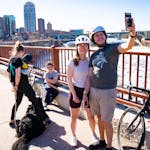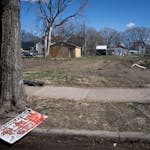Prosecutors attacked the theory that Justine Ruszczyk Damond struck former Minneapolis police officer Mohamed Noor's squad before he fatally shot her, calling a fingerprint specialist who testified Monday that none of the 51 prints lifted from the vehicle were hers.
The credibility of Noor's partner, Matthew Harrity, and a state investigator who helped spread the story that Damond slapped the officers' squad and startled the officers also came under fire as prosecutors continued to raise doubts regarding law enforcement's communication about Damond's death in 2017.
Minnesota Bureau of Criminal Apprehension (BCA) forensic scientist Jennifer Kostroski testified at Noor's murder trial that dozens of prints pulled from the rear, side and hood of the squad could not be traced to Damond, but that some results were inconclusive.
Later in his questioning, Assistant Hennepin County Attorney Patrick Lofton pointed out that some of the prints weren't tested until a few weeks ago — the latest disclosure of possible missteps in the investigation by the BCA. Prosecutors have called out both the BCA and Minneapolis police in court for their actions in the aftermath of the shooting.
Defense attorney Thomas Plunkett tried to steer the evidence in Noor's favor, confirming with Kostroski that she tested a limited number of prints a BCA agent at the scene collected and provided. Under his cross-examination, she also acknowledged that smears or a strike with the knuckles or the back of a hand would not leave prints.
"You cannot show that a specific person did not touch an object, isn't that correct?" Plunkett asked.
"Yes, that is correct," Kostroski said.
"It is not your scientific opinion that Ms. Ruszcyck did not touch the car?" Plunkett asked.
"That is not my scientific opinion," Kostroski said.
Kostroski's statements renewed the debate over whether Noor and Harrity were startled by a loud sound moments before the July 15, 2017, shooting.
The prosecution has gone to great lengths to dispel that narrative, pointing to Harrity's comments to his and Noor's supervisor, Sgt. Shannon Barnette, at the scene, which made no mention of a slap or noise.
The defense has argued that the officers were responding to Damond's 911 call about a possible sexual assault in the alley behind her south Minneapolis home and were about to leave when they heard a loud bang on the squad.
Harrity testified Thursday that he jumped in his seat, yelled and pulled his gun out next to his ribs.
Noor fired from the passenger seat through Harrity's open driver's side window about 11:40 p.m. because both officers thought they were being ambushed, the defense has told jurors.
Assistant Hennepin County Attorney Amy Sweasy pressed Christopher Olson, BCA assistant special agent in charge, for spreading the story.
Olson, whose late-afternoon turn on the witness stand will continue Tuesday morning, testified that Barnette shared the information with him.
Olson said he arrived at the shooting scene about 2:20 a.m. and was met by several Minneapolis police leaders, including Chief Medaria Arradondo.
They briefed him on the shooting, he said, but no one mentioned a noise on the squad car.
About 20 minutes later, he testified, he spoke with Barnette in the alley.
"What happened here?" Olson said he asked her.
"It sounds like she made contact with the car," he recalled Barnette saying.
Olson said Barnette reported having spoken with Harrity, and he assumed the information came from Harrity.
Olson contradicted himself on the stand, first saying he gave another BCA agent information that the agent wrote into two search warrants referencing a slap.
After Olson was asked to read that portion of the search warrant aloud in court, he backtracked and said he didn't provide the information.
Sweasy asked him for clarification.
"I think I supplied the word 'slap' to" the agent, Olson said.
Olson explained its origin in more detail.
Olson said he asked Barnette at the scene, "What sort of contact," and she called it a "slap."
Multiple body camera videos recorded at the scene, including Harrity's and Barnette's, showed Harrity telling Barnette that Damond "spooked" them and Noor fired his weapon.
The recordings do not show Harrity mentioning a noise or slap.
Barnette previously testified she believes the information she shared with the BCA about a noise came from officers at the scene guessing about what startled Noor and Harrity.
Sweasy asked Olson why he didn't have his colleague write in the search warrants that an officer had fired from inside a squad, information he knew at the time the warrants were being drafted to search Damond's home and the driveway where she was killed.
"I don't know," Olson said.
Earlier in his testimony, Olson said Minneapolis police shared little information with him as he and his colleagues investigated the death.
The BCA investigates Minneapolis officer-involved shootings.
"Frustrated," Olson said of his conversation with police leaders at the scene. "It just didn't make sense to me why this [officer] was shooting from inside of a squad car."
There was a "conspicuous" lack of information at the scene, he said, an issue prosecutors have shown impacted patrol officers who arrived as back up and medical personnel who tried to save Damond's life.
"It was clear to me that information would not be forthcoming," Olson said. "I just don't know that anyone had discussed what had happened at the scene there."
Prosecutors on Monday also took a shot at Harrity's credibility, and meticulously walked BCA agents through the timeline of their evidence collection, noting that it took months for Minneapolis police to provide body camera videos from the scene.
BCA special agent Doug Henning interviewed Harrity and Barnette about the shooting.
He said the 90-minute interview with Harrity occurred at the home of Harrity's attorney, Fred Bruno, an arrangement that prosecutors criticized in their opening statements.
Sweasy asked Henning if he knew who Harrity spoke to in the three days between the shooting and his interview.
Henning said Harrity spoke to his wife and Plunkett, who he had believed would serve as his attorney, and Bruno.
Sweasy asked if anything prohibited Harrity from speaking to others.
"No, but it's discouraged," Henning said.
Sweasy asked whether there was any reason the interview could not be conducted at BCA headquarters in St. Paul.
"No, there is not," Henning said.
He said that in the interview, Harrity mentioned a "noise" on the squad car and did not specifically say anything about a slap.
Under questioning by Sweasy, Henning testified that he interviewed Barnette for 12 minutes on Aug. 10.
That same day, the BCA received six squad camera videos and one body camera video from Minneapolis police.
It took "weeks" to get more body camera videos from police? Sweasy asked.
"They took a while, yes," Henning said.
Sweasy asked if the BCA was still receiving body camera videos on Oct. 24, 2017.
Yes, Henning said.
Plunkett tried to deflate the prosecution's focus on the interview at Bruno's home, where Henning said he was given coffee and a doughnut.
Plunkett asked if Bruno had concerns about Harrity's safety and the media following him.
Sweasy objected.
"As to Bruno," Judge Kathryn Quaintance said, "it's irrelevant."
On redirect, Sweasy continued to press on the Harrity interview.
"Is the BCA facility in St. Paul a safe place?" she asked.
Yes, Henning said.
"Is there a way to get a person in and out of there without the general public knowing?" she asked.
"Yes," Henning said.
"That's all I have," Sweasy said.
Chao Xiong • 612-673-4391 Twitter:@ChaoStrib
Libor Jany • 612-673-4064 Twitter:@StribJany




